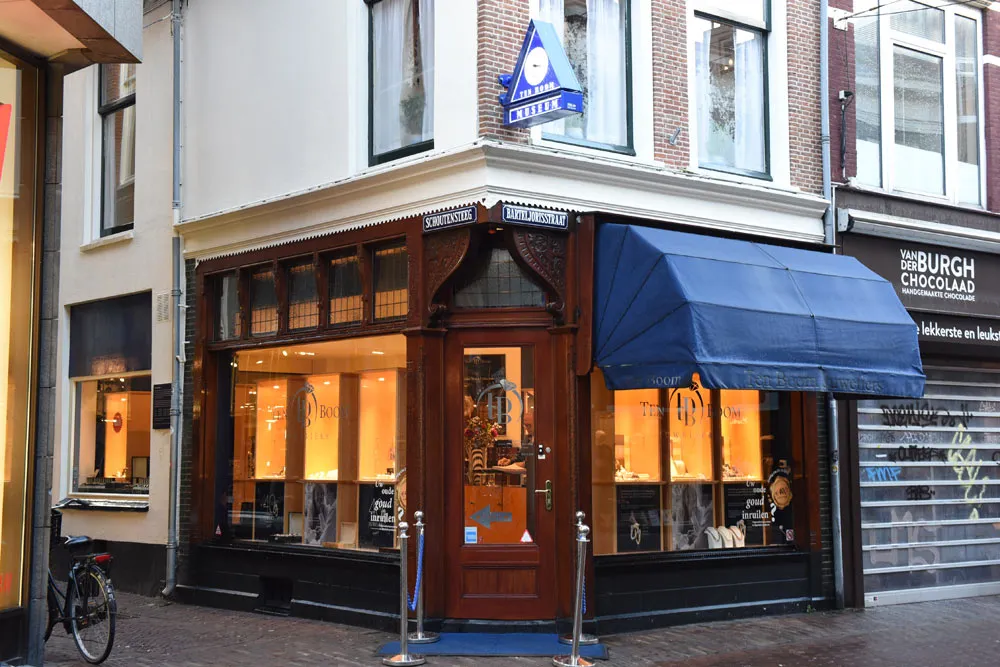I recently ran across a documentary on Amazon Prime called “Corrie Ten Boom: A Faith Undefeated (2013)” and thought it looked interesting so I decided to watch it and it turned out to be a very interesting story of a hero who was full of faith in Christ until the day she died. I’ll share some of what I learned with you here, but if you like what you are reading, I recommend you check out this documentary. It is likely available through various streaming services. Just search the title on your favorite search engine and you will surely find it.

Corrie Ten Boom was born on April 15th, 1892 in the Netherlands to Casper and Cornelia Ten Boom. Corrie was the youngest of her three siblings. Her father was a devout Christian man and held an occupation as a watchmaker / jeweler. In 1921 her mother passed away at the age of 61. After apprenticing for a time, in 1922, Corrie became the first female licensed watchmaker in Holland.
When Corrie was young, two of her Aunts came to live with their family. The home where they lived in Haarlem, Holland was no longer large enough to house the entire Ten Boom family so her father decided to purchase the adjacent house across the alley and connect the two homes by closing in the alley and adding a winding staircase between the homes. The reason the staircase had to wind was because the floors of each of the two homes were at different levels so the stairs had to wind around and allow access to each level of the newly combined home. Just to note, this home is now a Museum and can be visited in Holland. Corrie and her sister Betsie took good care of their Aunts until they ultimately both passed away. Eventually this left Corrie, Betsie, and their father as the residents of the Ten Boom home.

During World War II, Germany invaded Holland in 1940 and their operation lasted for five years. During this time, Corrie, her father, and her sister began taking in Jews who were seeking asylum from the Nazi’s. The Ten Boom home became known as an underground safe house. Corrie and her family had a big heart and were willing to put their own lives on the line to rescue the Jewish people from persecution and death.
There were a couple of codes that were used to know when someone needed to be taken in and also when it was safe to bring them into the home. A telephone “code” was created for fear the lines were tapped by the Nazi’s. The telephone code was for someone to call and say that they “needed a watch repaired”. Once it was determined someone needed to seek shelter in the Ten Boom home, there was a wooden sign in the front of their shop that was used as a coded message. The code with the sign was determined by which way the sign faced. If the colorful design of the sign faced out to the street, it was safe to bring people into the home. If the back of the sign faced the road, it meant it wasn’t safe and to stay away.
Eventually the Ten Boom home was full of Jewish refuges hiding from the Nazi’s. The Ten Booms assigned chores and other activities to keep them busy and they all became like one big family. A buzzer system was also installed throughout the house so that should a Nazi office come knocking at the door, everyone would be alerted. There was a very small space behind Corrie’s closet with a trap door entrance inside the closet in front of which Corrie kept a large suitcase to hide the entrance. Nazi officers also frequently would knock on the wall to see if it was hollow to indicate a hiding space. However, Mr. Ten Boom considered this when building the hiding place and built the wall that was in front of it into the floor and the ceiling so it would sound solid if knocked upon.

The Ten Boom’s became well known in the underground for taking in and rescuing Jews. Once someone asked them to take in a Jewish baby that was going to be killed and they quickly agreed. Then on February 28, 1944, another man came knocking at the door stating that he understood they took in Jewish people and he said his wife was in prison, but the guard had agreed to release her if the man would pay him. Corrie agreed to help pay off the guard; however, it turned out that this man was a deceiver and he turned the Ten Boom’s in to the Nazis. Shortly there after the Nazis came to the Ten Boom home and when Corrie’s sister opened the door, they pushed their way in. Thankfully there was a buzzer near the door and her sister was able to press the buzzer to alert the household of the invasion. This is where the design of the new home comes into play. You see, the Ten Booms had implemented an emergency preparedness plan and practiced it time and time again. Any time the buzzer was pressed, they had to clear their plates at the table, leaving only three place settings and gather their belongings and make it to their hiding place behind Corrie’s closet, which was on the top floor of the home and the farthest room from the front door of the home, all within 60 seconds. It was likely because of the practice drills that they were able to make it to the hiding place and those six people were not found by the Nazis that day. However, Corrie and her family were immediately arrested and taken to prison.
Corrie’s father was 84 years old when he was taken to prison and he died just 10 days after his arrest. Corrie’s brother, Willem, and his sister, Nollie, were soon released. However, over the next several months, Corrie and Betsie were taken from camp to camp, finally ending up at the largest concentration camp for women controlled by Nazi forces. This camp was called Ravensbruck and was located in Berlin.
Corrie and her sister lived in deplorable conditions with malnutrition, fleas, and other pestilence. It was so bad, in fact, that the Nazi guards wouldn’t enter the living quarters. They would only set the food inside the door. This led to Corrie putting together Bible Studies and preaching the Gospel of Jesus Christ to others in the camp. Corrie had a tiny, smuggled Dutch Bible that was missed by the guards upon entry. Corrie had prayed to the Lord that he had opened the eyes of the blind and she prayed that God would now close the eyes of the Nazi’s so she could keep her Bible. The Lord answered Corrie’s prayer. As she was moving through the line, when it was her time to be searched, the guard got distracted with another prisoner and she was ushered in without a search allowing her to keep her Bible hidden. She and her sister used that Bible to, very likely, lead many to Christ right there in the concentration camp. Thousands of women died at this camp, including Corrie’s sister Betsie. On December 16, 1944, Betsie died of starvation and lack of medical care. However, many of the other woman were put to death through the horror of live cremation. The women would be sent into a room being told they would be able to take a shower an instead it was a crematory where they were burned alive.
The women were all assigned numbers to identify themselves and Corrie said that one never knew when their number was called if it was to go to the crematory, to truly have a shower, or to be released. Two weeks after Betsie’s death, Corrie’s number was called. To her surprise, she was taken to an office and provided clothing and her release papers. Corrie called this a clerical error of man and a miracle of God because shortly after her release, all of the other women of her age were executed.
After her release, Corrie started a post-war ministry that spanned decades. Corrie leased a home in Bloemendaal that she made into a home for concentration camp survivors, fellow wartime resistance collaborators, and the disabled. She set up a non-profit organization in the Netherlands to support her home and ministry. Corrie traveled to 64 countries speaking and preaching the Gospel of Jesus Christ. She wrote a book in 1971 and had a movie made about her in 1975. As she began to age, Corrie settled in Palcentia California in 1977. In 1978 she had the first of several strokes which took away her ability to talk. Corrie died on her 91st Birthday on April 15, 1983 after spreading the Gospel to millions of people all over the world.
Sources
Corrie Ten Boom: A Faith Undefeated (2013) – https://www.amazon.com/Corrie-ten-Boom-Faith-Undefeated/dp/B00L416LQ6 http://www.inspirationalchristians.org/biography/corrie-ten-boom/attachment/ten-boom-family/ https://www.learnreligions.com/biography-of-corrie-ten-boom-4164625 http://2.bp.blogspot.com/-t0yS-qYsizY/VYG-6jLdbxI/AAAAAAAADj8/AK1zXWw-DVQ/s1600/59b7880e7c.jpg http://jontrott.com/wp-content/uploads/2014/05/hiding-place.jpg

 Bradley is a Business Analyst, Project Management Professional, and Software Developer who enjoys spending time with family and friends. He is happily married with three kids and enjoys cooking, music, simulator games, and various other hobbies.
Bradley is a Business Analyst, Project Management Professional, and Software Developer who enjoys spending time with family and friends. He is happily married with three kids and enjoys cooking, music, simulator games, and various other hobbies.